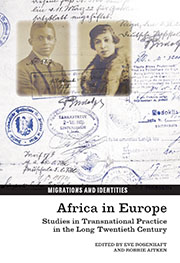Book contents
- Frontmatter
- Contents
- Acknowledgements
- List of Illustrations
- List of Abbreviations
- List of Contributors
- 1 Introduction
- I Enacting Identity: Individuals, Families and Communities
- II Authenticity and Influence: Contexts for Black Cultural Production
- 6 Féral Benga's Body
- 7 ‘Like Another Planet to the Darker Americans’: Black Cultural Work in 1930s Moscow
- 8 ‘Coulibaly’ Cosmopolitanism in Moscow: Mamadou Somé Coulibaly and the Surikov Academy Paintings, 1960s–1970s
- 9 Afro-Italian Literature: From Productive Collaborations to Individual Affirmations
- III Post-colonial Belonging
- IV Narratives/Histories
- Bibliography
- Index
6 - Féral Benga's Body
from II - Authenticity and Influence: Contexts for Black Cultural Production
- Frontmatter
- Contents
- Acknowledgements
- List of Illustrations
- List of Abbreviations
- List of Contributors
- 1 Introduction
- I Enacting Identity: Individuals, Families and Communities
- II Authenticity and Influence: Contexts for Black Cultural Production
- 6 Féral Benga's Body
- 7 ‘Like Another Planet to the Darker Americans’: Black Cultural Work in 1930s Moscow
- 8 ‘Coulibaly’ Cosmopolitanism in Moscow: Mamadou Somé Coulibaly and the Surikov Academy Paintings, 1960s–1970s
- 9 Afro-Italian Literature: From Productive Collaborations to Individual Affirmations
- III Post-colonial Belonging
- IV Narratives/Histories
- Bibliography
- Index
Summary
My first encounter with the name ‘Féral Benga’ occurred many years ago while conducting preliminary research on the role of sculptural traditions and practices in African American art. Féral Benga was the title given to a 1935 statue by the renowned African American sculptor James Richmond Barthé (1901–89) (Figure 3).
I learned subsequently, however, that Féral Benga's influence and importance to the story of Africans in the modern world went well beyond this singular work of art. My later search into the meaning of Féral Benga led to a discovery that the African, African American, and European encounter with modernism was not always as confrontational as we are sometimes led to believe and that such engagements could combine in a variety of ways to contribute to a productive crossroads. This chapter is about various visual and verbal encounters with Féral Benga's body by a handful of modern artists and writers of the early twentieth century. Through them, I discern ways in which the black male form expresses the potential to serve as a viable means of affirming a combined racial and sexual identity as a significant aspect of modernist and afromodernist practice. By afromodern, I refer to an array of ambiguous psychological strategies and lived experiences by those of the black diaspora that helped to generate and illuminate significant meaning within European and American modernist concerns and conceits. Féral Benga's body, visual and verbal references to it, and the homoerotic Utopias (what I call homoutopias) scripted onto it, all constitute many fertile crossroads.
- Type
- Chapter
- Information
- Africa in EuropeStudies in Transnational Practice in the Long Twentieth Century, pp. 99 - 119Publisher: Liverpool University PressPrint publication year: 2013

